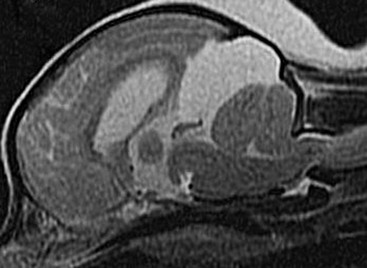Chapter 226 Diagnosis of IAC typically is made via computed tomography or (preferably) magnetic resonance imaging (Figure 226-1). IACs also can be visualized using ultrasound imaging (via the foramen magnum, a temporal window, or a persistent bregmatic fontanelle), especially in younger dogs. The characteristic appearance of IAC is that of a large, well-demarcated fluid-filled structure that is isointense with the CSF spaces and is located between the caudal cerebrum and rostral cerebellum. Because IAC may be an incidental finding, it is important to rule out concurrent inflammatory disease (i.e., by CSF examination). In the author’s opinion, it is often difficult or impossible to discern whether IAC in the presence of another brain disorder is purely an incidental finding. Since the presence of a large fluid-filled structure within the cranial vault likely decreases intracranial compliance, some IACs may contribute to clinical signs rather than being simply an incidental finding. Because this disorder is believed to represent a developmental abnormality of the intracranial ventricular CSF system, it may occur concurrently with other fluid abnormalities (including congenital hydrocephalus). The cyst may or may not communicate with the remainder of the ventricular system. When one is faced with evidence of IAC and another disease (e.g., granulomatous meningoencephalitis) in the same patient, obtaining an optimal response to treatment may entail treating both conditions.
Intracranial Arachnoid Cysts in Dogs
Clinical Findings
< div class='tao-gold-member'>
![]()
Stay updated, free articles. Join our Telegram channel

Full access? Get Clinical Tree



